Imagine this. It’s a beautiful, crisp autumn afternoon and you are out in the wooded foothills of the western Cascade Mountains for a week-long, solo hunting/fishing/camping trip during which you plan to live off the land. You are out for the 1st hunt, excited to be carrying your new Browning X-Bolt 2 bolt-action hunting rifle chambered in 6.5 Creedmoor. You hike down toward a shallow river, figuring there might be a good chance of finding a young deer.
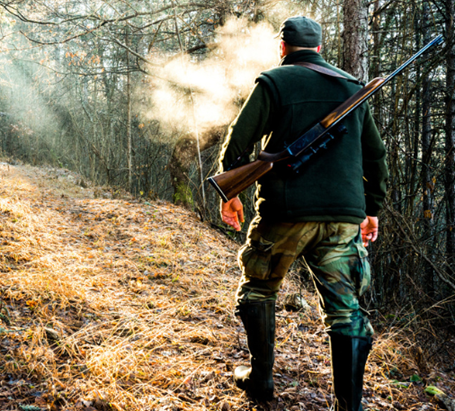
As you hear the babbling river waters coming up before you, the notice the woods up ahead starts to clear and slowly reveal a beautiful meadow on the other side of the river, with another tree line arising around 150 years beyond that.

As you emerge from your own wooded tree line, you pause, shocked by what you see. There’s a small herd of moose in the meadow! You can see a huge bull donning an enormous rack of antlers, strutting about in full-blown rut mode.

Close by him, there are at least a couple of adult cow moose, accompanied by at least 3 calves nearby that have not yet weaned from their mothers.

Your plans have drastically changed! Now you want your 1st set of antlers! You slowly raise your rifle, trying not to draw any attention, hoping that your new bang bang stick’s ammunition is not too small for that huge bull. You set your aim in your rifle’s scope and are ready to pull the trigger when suddenly, in the distance, appearing above that bull’s back, you see a huge brown bear emerge from the opposite tree line across the meadow.

The bear slowly begins to stalk one of the calves. You realize that you are about to witness an amazing sight, straight out of those nature documentaries. But you also realize that if you shot the bull moose, it would be claimed by the bear! You lower your rifle for a moment, unsure of what to do.

Then you see the bear begin to charge the herd. The bull moose, startled by the approaching bear, emits a stunningly loud bellow.

The bear aggressively turns toward the bull, itself huffing, grunting and then roaring an aggressive growl as it runs toward an epic fight. The bull crouches, head down, to present its dangerously pointed antlers toward the big bruin as the calf runs away.

The bear, realizing the danger of attacking such a strong, well-defended bull moose, sidesteps the bull’s antlers and begins to attack one of the cows, trying to climb onto her back!

The remaining cows and calves jump in panic and begin running toward the other side of the river.

The bull, itself suddenly fearful of the enormous bear’s fierce power, also breaks and scrambles with the herd.

The hangry bear, not giving up on a fine, pre-hibernation meal, gallops in close pursuit.
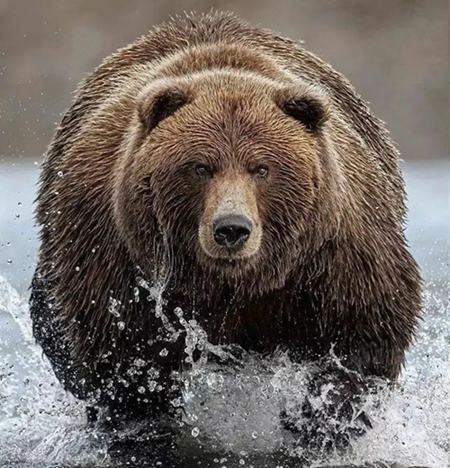
You suddenly realize that all these giant beasts are running right at you! In a panic, not knowing what else to do, you quickly raise your rifle and take aim at the scrambling pack rushing toward you. You point and pull the trigger, but all you hear is a click – nothing else. You immediately realize you hadn’t chambered a round! You immediately pull back on the rifle’s bolt lever and then quickly push it forward again. But you don’t feel the expected resistance of a round being chambered! You realize you forgot to insert the magazine! But now it’s too late! The herd has crossed the river and is now racing up the path where you stand like an out-of-control, speeding freight train!
In blind fear, all you have time to do is react by turning your back to the chaos of the charging animals. The bull moose, now in the lead, runs right up to you in full sprint and with its massive, rippling shoulder, blasts into you. You bounce off the rushing bull moose like a pinball! Your body flies through the air and you land, face first, into a nearby patch of gloopy mud.
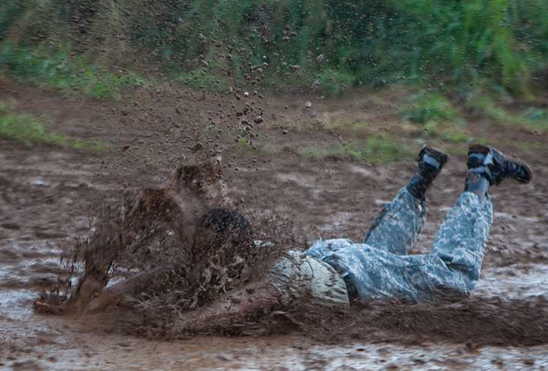
You lay there, motionless, your head swirling from the impact, in abject fear that you might be trampled by the remaining stampede or even attacked by the bear. You also realize you have no idea where your rifle landed! After what seems like an eternity, the earth finally stops trembling under the weight of the barreling beasts having passed by. You lie still for a moment or 3 longer, face down in the mud, listening intently for any signs that the enormous, brown grizzly ursid might still be close by.
After you’re convinced you’re alone, your head still swimming from the stunning body blow, you slowly make your way back up onto your feet. You dizzily look around you, not really sure of what you see. But as the dizziness subsides, not more than 10 feet away, you see what you think is black-tailed jackrabbit.

You stumble forward a couple of steps and you realize that the jackrabbit had been stomped into the ground by the stampede, leaving it mostly in the form of a mashed blob of fur on the ground.

But with nothing else to hunt in sight, in your eyes, that’s dinner! At this point, there’s only one thing left to do – you need to skin that roughed up rabbit furball so you can cook it!
You reach into your jacket pocket and retrieve your Benchmade Mini Crooked River pocketknife! Moments later, dinner is served!
Aren’t you glad you carried a Benchmade?
TL;DR
The Mini Crooked River is another in Benchmade’s line of hunting knives. It’s a visually appealing knife, equipped with beautiful burnt copper-anodized aluminum bolsters and lightly contoured black Micarta scales. The blade is made of CPM MagnaCut that sports a DLC “stonewash” finish and a pair of easy-to-use thumb studs. Of course, it’s equipped with the legendary Benchmade AXIS Lock. The handle is comfortable to hold, and the blade is easy to deploy. The pocket clip is black-coated, medium-carry, stamped steel with medium retention.
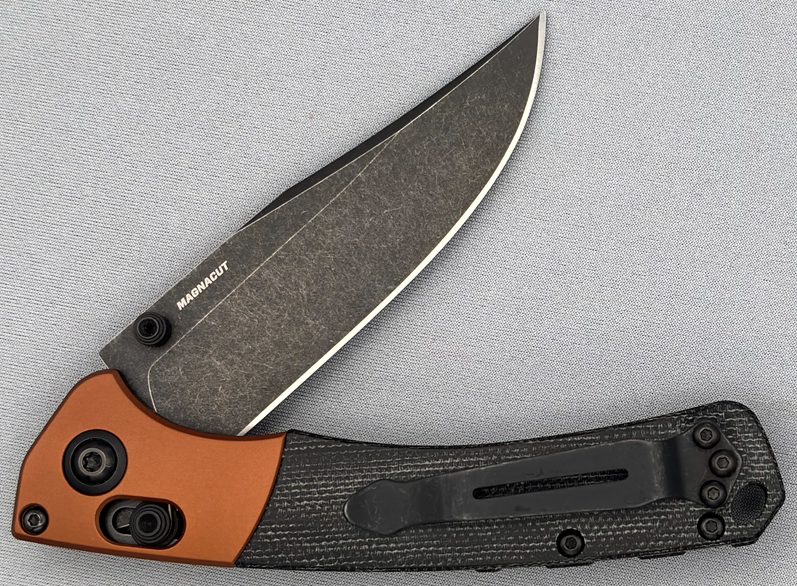
It sounds all good, right? Well, there’s more to the story. The blade edge bevels are unevenly ground. The lock’s crossbar pin has so much lateral play that you can’t unlock the blade by pulling back on 1 side alone. The thumb studs have hollow tips so that they can be removed with a T6 bit, but those unfinished tips result in the studs being uncomfortably sharp and abrasive. The washer-based pivot is not smooth whatsoever – in fact, it’s very gritty and grabby. The handle uses cheaper stacked, not nested, liners. There are unnecessarily wide gaps between the bolsters and the scales, and the seams where separate handle materials are supposed to match up to the liners, there are uneven ledges, showing disappointing manufacturing tolerances and disappointing craftsmanship. Lastly, the MagnaCut blade is only hardened to 60-62 HRc. That’s at least 1-2 points below what should be expected in 2025.
And you get all this quality for the cost of a mere $320. Riiiiight.
Pros
- Handsome knife; bolsters look great
- MagnaCut is always a good blade choice
- Ambi pocket clip and ambi AXIS Lock
- Thumb studs make blade easy to open
- Detent hold is relatively impressive for Omega springs
- Has a backspacer
- The scales are slightly contoured
- Uses Chicago rivet style screws for show side fasteners
Cons
- Blade edge grinds uneven
- Aluminum & Micarta for the price they’re charging?
- Can’t unlock blade with one finger – AXIS Lock bar has too much lateral play and binds on blade tang
- Quite a bit of lock stick
- Needlessly deep gap between bolster and scales is the perfect place for animal guts to collect on a hunting knife
- The seams of liners on bolster and liners on scales are not done well – fit and finish is, at best, mediocre
- DLC Blade made to look like cheap blackwash
- HRc for MagnaCut blade 2 points too low
- Thumb studs of both the blade and the AXIS Lock come to sharp-edged hollow points at apex, which makes them needlessly abrasive to thumb skin
- Open stop pin uses dual, unsightly, external mounting screws!
- Uses cheap stacked liners rather than nested liners
- No blade jimping – on a hunting knife!
- The ramped bill of the stamped pocket clip digs into the palm of your hand
- The pivot, out of the box, is very grabby and gritty
- T6 handle fasteners! Still?
- 3 screws for medium deep pocket clip
- For all the above, considering the value, the price is too damn high!
Tech Specs
Brand | Benchmade |
Website | |
Manufacturer | Benchmade |
Origin | Oregon City, OR, USA |
Model Reviewed | Blue Class Mini Crooked River 15085BK-04 |
Designer/Design | In-house |
Model Launch Year | 2025 |
Style | Folding knife |
Lock Type | AXIS Lock |
Opening Type | Manual |
Opening Mechanism(s) | Thumb studs |
Pivot Type | Captive, black semi-gloss-coated steel pivot using rounded, shallow dome shape and a T10 fastener. Both sides are encircled with black semi-gloss-coated pivot collars |
Pivot Mechanism | Phosphor Bronze washers |
Length Closed | 114.68 mm / 4.516" |
Length Opened | 199.74 mm / 7.864" |
Weight | 94.67 g / 3.34 oz. |
Original Packaging | Heavy, rigid, Blue Class paperboard, full telescope box and a dense, black, medium-soft, large closed-cell foam lining pressed into the lower tray. Knife is enclosed in a black, satin, drawstring bag & box includes thick cardstock AXIS Lock slip and a rectangular-folded Use & Care sheet. |
MSRP & Retail Price | MSRP: $320 |
Edge | Plain |
Shape | Clip Point |
Material | CPM MagnaCut |
Claimed Hardness HRc | 60-62 |
Blade Length | 88.56 mm / 3.487" |
Weight-to-Blade-Length Ratio | 1.07 |
Cutting Edge Length | 89.74 mm / 3.533" |
Primary Bevel Half Angle | 3.5° |
Original Edge Half Angle | 17.5° |
Height | 23.99 mm / 0.945" |
Spine Thickness | 2.86 mm / 0.113" |
Main Bevel Edge Thickness | 0.56 mm / 0.022" |
Thumb Studs Span | 9.40 mm / 0.370" |
Finish | Stonewashed DLC |
Features | A long, narrow blade nice grid lines between the swedge, the flat and the primary bevel. The finish is DLC that was then stonewashed to give it a gray, mottled appearance. The thumb studs are removable, which could be a good idea in theory, but give the T6 socket hole a needlessly sharp perimeter edges. The thumb studs do extend into the cutting path. The blade has no jimping. |
Grind | Very high flat grind with top flat |
Swedge | Height: 2.19 mm / 0.087" |
Fuller | None |
Jimping | No blade jimping |
Blade Markings | Show side: Printed company logo below the spine, starting in the flat and finishing on the primary bevel near ricasso |
Sharpening Choil | Length: 7.73 mm / 0.305" |
On-Blade Opening Assists | Thumb studs |
Thumb-Stud-in-Cutting-Path | 9.16 mm / 0.361" |
Materials | Canvas Micarta with 6061-T6 anodized aluminum bolsters |
Color | Black Micarta and Burnt Copper bolsters |
Scale Thickness (includes liner) | 4.59 mm / 0.181" |
Scale Texture | Smooth Micarta |
Handle/Scale Features | Smooth aluminum bolsters and black canvas Micarta scales are lightly contoured and feel good in the hand (would be greatly improved with a better pocket clip!). The burnt copper bolsters really give the handle stand out, visual appeal. However, for detail freaks, there are numerous, small but annoying fit and finish problems at materials seams. The lock bar has too much lateral play, preventing lock disengagement with 1 digit. |
Liner Type | Stacked steel |
Opening Stop Pin Type | Single, externally-fastened stop pin in top front corner of handle. Serves as both open and close stop pin. |
Closing Stop Pin Hits Sharpening Choil | No |
Handle Length | 114.68 mm / 4.516" |
Blade-to-Handle Ratio | 0.77 |
Closed Knife Handle Height | 28.58 mm / 1.125" |
Handle Thickness | 12.36 mm / 0.487" |
Detent | Omega springs |
Pivot-Center-to-Thumb-Stud | 24.52 mm / 0.966” |
Thumb-Stud-Angle-from-Vertical-Center when closed | 31° |
Thumb-Stud-Tip-to-Scale-Edge-Clearance: Show Side / Clip Side | 3.09 mm / 0.122" |
Pivot-Center-to-Open-Knife-Fulcrum | 17.05 mm / 0.672" |
Crossbar Lock Thumb Studs Width | 12.00 mm / 0.473" |
Integral Handle | No |
Backspacing Type | Backspacer |
Backspacing Material | Canvas Micarta |
Backspacing Color | Black |
Backspacer Length | 48.31 mm / 1.902" |
Backspacer Features | Crenulated texture |
Lanyard Mount | Handle hole |
Pocket Clip | Stamped, medium carry |
Clip Material | Steel |
Clip Color & Finish | Black oxide |
Clip Placement | Ambidextrous, Tip-Up |
Clip Length | 58.69 mm / 2.311" |
Clip Length-to-Handle % | 51.18% |
Clip Features | Split-arrow stamped steel clip with an uncomfortably high ramped bill. |
Fasteners | Black anodized T6 fasteners, 6 on clip side (1 for stop pin; 2 for scales; 4 for pocket clip). Show side scale screws are Chicago-style rounded rivets, Only screw with socket is stop pin. |
Introducing the Benchmade Mini Crooked River
Benchmade describes its Crooked River line of knives as “a traditional shape combined with modern technology that pushes the preconceived notions of what a hunting knife should be.” OK. I guess it does. I mean, I actually didn’t know that folding blades were used as hunting knives (can you tell I’ve never gutted and skinned an animal, aside from a fish?). I did a quick check on KnifeCenter and BladeHQ and learned their percentages of hunting knives that were fixed blades were not 100%, but just 71% and 83% respectively. Who knew?

But in my opinion, this looks like a simple, straightforward EDC folding pocketknife. I don’t see any features in particular that make it a hunting knife. To me, when I think of a hunting knife, I think of a Pendleton skinner, a Canadian skinner, or the classic Nessmuk knife. Am I missing something? Perhaps the Mini Crooked River is what someone at Benchmade, a knife designer who doesn’t like utilitarian, fixed blade hunting knives, simply labeled the Crooked River knife design a “hunting knife” because, well…, just because. Whatever. I’ll play along (maybe).
The initial version, the full-size 15080 Crooked River, was released in 2016, and the first Mini Crooked River followed that in 2017.
It’s a good-looking knife that has fairly good ergonomics. But it’s far from perfect. Really far, in fact. We’ll get into those details below.
The Origin of the Name
The real Crooked River is situated on the eastern side of the volcanic Cascade mountains in Oregon. Not coincidently, Oregon is the same state in which the Benchmade Knife Company is headquartered. The Crooked River is a mere 121 miles from Benchmade, so it’s likely that many in Benchmade know the area well.
This gentle river, a 125 miles (201 km) long tributary of the Deschutes River (which itself is a major tributary of the mighty Columbia River), is not a large river with its modest 1,544 cubic feet per second discharge rate. Like many of the smaller rivers in the Pacific Northwest, it’s a fly fisherwoman’s paradise, with copious numbers of Redband rainbow trout and mountain whitefish just waiting for you. All you need is a good roll cast and you’ll be hooked (Ha! See what I did there?).

And not only is the river itself simply gorgeous, it runs through the stunningly beautiful, stepped, canyon-like eastern Cascade foothills. The hunting opportunities in the Crooked River are ample as well. One can bag their own pronghorn, Roosevelt elk, and mule deer, or even jackrabbit, not to mention duck and geese. Of course, you can just go there for hiking, backpacking, camping, wildlife and nature observation, whitewater boating, picnicking, swimming, and photography.
Understanding Benchmade Knife Classes
With my past posts titled, “Benchmade Mini Adamas: Mammoth MagnaCut at a Problematic Price” and “Benchmade Shootout: An OTF in the Back of the Pack”, this’ll be my 3rd review of Benchmade knives – 4th if you count my analysis post called “Benchmade Mini Adamas: Anatomy of a Counterfeit Knife”.
In my posts, I like to add a little bit of color and perhaps offer some otherwise interesting insight into lesser-known aspects of either the knifemaker (the person) or the brand (the company). But I have covered a lot of that already in those aforementioned posts. So this time, I’d like to add a bit of information about the knife class categories used by Benchmade.
Benchmade has sold knives in each of the following class categories:
- Blue Class
- Black Class
- Gold Class
- Water Collection
- NSN Military & Government
- Red Class (deprecated in 2010)
- Hunt Class
It appears that Benchmade began using the color classes around 2004 and have since expanded them beyond mere colors today.
So what are these product classes and what do they include? Let’s take a brief dive into Benchmade product marketing and see what this is all about.
- Blue Class knives, launched around 2004, are what Benchmade declares to be their EDC class, although it contains folders, fixed blades, and even Balisongs! Blue Class knives include the Bugout, the Osborne, the Griptilian, the Freek, the Necron and the Bushcrafter (a 9+” fixie! Maybe Benchmade thinks a knife this size is an EDC, but I beg to differ).
- Black Class knives, also starting around 2004, are the category for tactical knives. So what’s a tactical knife? I can tell you it’s not a knife used for conducting clever planning to reach a longer-term end goal, such as organizing a class reunion (although given old grudges, maybe tactical blades might be useful there after all). No, in this context, tactical means military, the use of arms and weapons to conduct an immediate operation (versus working toward long-term goals, that’s called “strategery”. Heh heh). In the Black Class are knives from such product lines as the Adamas, the Claymore, the SOCP (Special Operations Combatives Program), the Shootout, the Casbah, the Presidio and several more.
- Gold Class knives, established in 2005, are for “collectors and connoisseurs”, you know, the folks who have far more money than the rest of us do to pay the exorbitant Butterfly tax. These limited run knives are where Benchmade uses what they call “exotic materials” such as Damasteel, carbon fiber, titanium, Timascus and other stuff we see all over the rest of the higher-to-premium end of the pocketknife market, almost always for much lower prices. As I write this, there were only 2 Gold Class knives for sale on the Benchmade website: a pair of Necron Balisong knives with 4.5” Damasteel blades and FatCarbon handles. For $1,300. Yeah, that damned Butterfly tax is wicked bad.
- The Water Collection, introduced in 2024, is for folks who do stuff on or around water. Like fishin’. And killing fish. And cutting fish. But as Benchmade says, it’s not just a “fishing knife line”. It claimed to even stand up to saltwater environments (although apparently the omega springs used in at least 1 knife in the water Collection are not saltwater-proof, at least according to this dude). Seriously? C’mon people! The Water Collection includes fillet knives (or as the British pronounce it, fillet knives!) such as the Fishcrafter, fixies like the Intersect and the Undercurrent, and the infamous, rusty-omega-springed Adira.
- The NSN, which stands for National Stock Numbers, are codes used by governmental procurement to purchase such tools in bulk. As of the 2024 Benchmade catalog, there were 15 knives and tools categorized as NSN, including well-known folders such as the Adamas, the Claymore, and the Casbah (those are also in the Black Class); side-deployed, switchblade versions of the Presidio and the Triage; OTFs such as the Infidels; fixed blades such as Adamas and the H2O; and fixed daggers like the SOCP. (The guvmint folks get all the auto knives while so many of us out here in various states remain under archaic, anti-switchblade laws passed way back in the 1950s.)
- Red Class, inaugurated in 2005 but then canceled around 2010, was a category of Benchmade knives that were made overseas (not US Made? Oh, the humanity!) that used cheap materials, made cheaply, and were priced accordingly (cheap – but the onerous Butterfly tax surely still existed back then, right?). These were basic beater knives right out of the box.
- Hunt Class, revealed in 2014, is, well, sort of self-explanatory category, right? These are hunting knives, which include both fixed and folding blade knives. Model lines include the Taggedout, the Meatcrafter, the Saddle Mountain, the Steep Country, the North Fork, and the knife in this review, the Crooked River (well, the mini one). Many Hunt Class knives come with SelectEdge, a “proprietary” 14° edge angle (“Don’t yoo be sharpenin’ yer knaf down to furtene degrees – that’s prop, that’s proep, perpri, that’s Benchmade’s angle!”). Sadly, according to the Benchmade website, the Mini Crooked River doesn’t come in Select Edge. Oh, dang. But the knife’s box says it does. Oh , yay. Which one is wrong? Oh, I don’t know.
Now, when you want to go shopping for a new Benchmade knife but you don’t know which model to get, well, shop the categories and, well, you might find it just a smidge easier. Maybe. Or you can do what most people do and simply ignore that nonsense.
Interestingly, the Mini Crooked River, according to the box, is a Blue Class knife (shown later on in the Original Packaging section). In a different section of the label that looks to be usage applications, it says Hunting, but it also says Every Day. So much for understanding Benchmade class categories!
Details and Specs
I’m done telling stories (not really). Let’s get into discussing the Benchmade Mini Crooked River pocketknife.
Blade
The Mini Crooked River comes equipped with a blade.
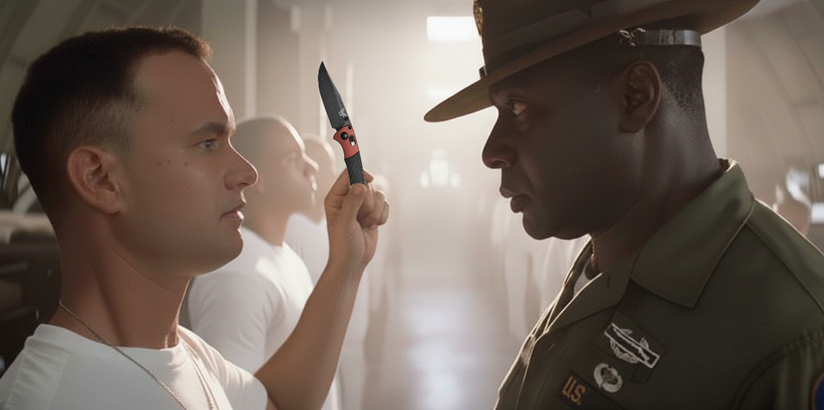
“Well, you’re a goddamn genius, Gump!”
So what about it? Well, read on.
Blade Features
Benchmade uses the ultra-premium, powder metallurgy steel CPM MagnaCut in its clip point blade on the Mini Crooked River. It features 3 blade grind areas: a primary bevel (of course), a flat on which the thumb studs are attached and extends from the ricasso ~2/3s the way down the spine, and a narrow swedge that starts just before the clip point’s clipped point and runs through to the tip. The grind lines separating each section are crisp and well-defined.

The finish unfortunately looks to be plain old, cheap blackwash. This gives the knife a disappointing first impression for those who can see the blade is made of MagnaCut and know what this knife costs (which we’ll get to soon). But rest assured, my bevel-besotted blade buffs, things are not exactly as they seem. For reasons unknown, Benchmade seems to be, at times, all about under-promising and then under-delivering (as Billy Joel, once said, “Don’t ask me why”). However, blackwash, a popular blade finish found on many a $20 pocketknife, at least on this Mini Crooked River, is not blackwash. It’s DLC! You heard me! It’s (claimed to be) freakin’ actual Diamond-Like Carbon!
You know, the same DLC made of a hexagonal carbon-atom lattice crystal structure called lonsdaleite, which was discovered in the 1960s as naturally occurring meteorite debris at Meteor Crater, Arizona (how cool is that? A cosmic gift to premium knife enthusiasts!). While sharing some properties similar to the more well-known, cubic carbon lattice crystal found in diamonds, DLC coatings are flexible and unstructured, meaning they can be applied to any surface that is compatible with the high heat and vacuum environment requirements of its application. And theoretically, pure sp3 (single-bonded) carbon atom-based DLC should be 58% harder than cubic crystal diamonds! Yeah, that DLC!
But Benchmade being Benchmade, instead of applying DLC to create a rich, dark-gray-to-black blade coating, they took their base DLC-coated blades and then ran them through a stonewash tumbling machine to degrade the DLC coating to the mottled, quasi-blackwash-looking finish you see on the Mini Crooked River. SMH.

Unfortunately, the blade edges are asymmetrically ground. The tip is ground to a shallower angle than the heel, and the show side is worse than the clip side. Where did the quality craftspersonship go, Benchmade? You weren’t like this in the past.
Opening Mechanisms
The Mini Crooked River offers 1 on-blade opening method: thumb studs. They are well-positioned just below the blade spine. The angle of positioning on the blade from the pivot to the handle centerline is a narrow 31°, a shallow angle which can sometimes make the studs harder to use due to reduced leverage. However, the narrowness of the knife overall forced that issue, so Benchmade made excellent accommodations by lengthening the distance between the studs and pivot to an easy-to-use 24.52 mm / 0.966”. They also added plenty of accessible stud distance from the edge of the bolster, all which returned the lost leverage to make the studs as useful as possible. Well done, BM!
The one drawback of the studs’ placement is that they fully intrude into the cutting path by 9.16 mm / 0.361″. If you’re cutting cardboard, that could be an issue if you tend to push the blade all the way in to cut at the blade heel. If so, you’ll need to adjust your technique a bit. But stud intrusions shouldn’t be as much of a problem when gutting roadkill possum, right?
However, as previously mentioned, Benchmade inexplicably opted to use removable thumb studs, which are detached via T6 sockets at the tip of the studs. The perimeters of those sockets are surprisingly sharp and uncomfortably abrade the skin of your thumb. In the photo below, it may not look like much, but trust me, these things bite.
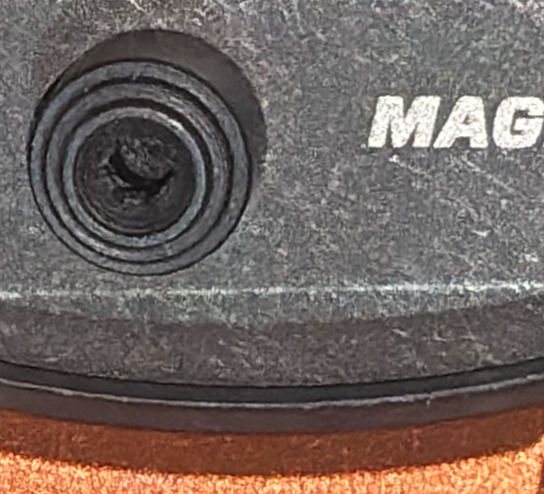
Perhaps Benchmade might argue that the sharp stud tips were used to help users manipulate the knife in gloved hands. I’d argue that the studs, whose span width is narrower than the handle body, could be slightly taller to make that accommodation, making the studs more comfortable to use in non-gloved hands. And besides, as the Mini Crooked River is earmarked as a hunting knife, those stud sockets are just another needless place for guts and goo to collect and make the knife stink. YUCK!
Spine Features
Thankfully, the edge between the flat and the spine isn’t a wicked sharp, “unfinished Spyderco spine” edge. Benchmade took what is a 90° edge angle between the flat and the spine and just barely kissed that edge on a grinder, just a quick smooch and that was all. But that was all that it needed to keep it from being so uncomfortably sharp – like the thumb studs.

The blade spine is 100% free of desirable features such as jimping or crowning. The omission of blade spine jimping is a surprise to me. For what is supposed to be a folding hunting knife, a tool that that will be used in the wet and gross environment of bloody animal flesh, innards and entrails, all of which will be slippery (I guess – I’m not a hunter), this is a very strange feature to leave off the knife. I can’t understand that one.
Choil
The sharpening choil, 7.73 mm / 0.305″ long and 3.63 mm / 0.143″ deep, is decent enough to last through several rounds of sharpening. The blade is not hollow ground, so as you remove material in your sharpening regimen, the behind-the-edge (BTE) thickness will increase over time. Maintaining the same edge bevel will only result in a notable wedge between the bevels, reducing sliciness.
Sharpen a Widening BTE Bevel
To manage the BTE as it grows ever thicker with each sharpening, you can thin out the primary-to-edge bevel interface by adding a small, intermediate “thinning” bevel between the 2. The goal would be to add the new bevel of extending just a couple of millimeters above the existing edge bevel, grinding it on a coarse stone to an angle of 8° to 12° per side reaching close to, but not exactly to the final edge. This will reduce the BTE width. Once the new intermediate, thinning bevel is done, you can return to sharpening the edge bevel to the factory grind (in the case of the knife in my review, according to my cheap, laser goniometer, 17.5° half angles, although EdgeSelect is supposed to be 14°, so whatever). This BTE thinning effort will keep the blade slicey sharp for your favorite dead animal dismembering activities. And since CPM MagnaCut is plenty tough, it will continue to serve you well.
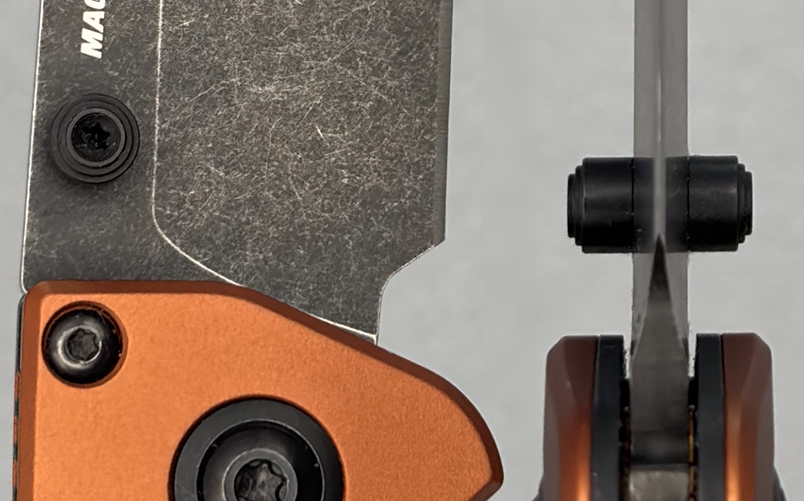
Blade Markings
In typical Benchmade fashion, the blade markings are predictable. That means having the somewhat large schmétterling brand logo on the show side and the steel name on the clip side.
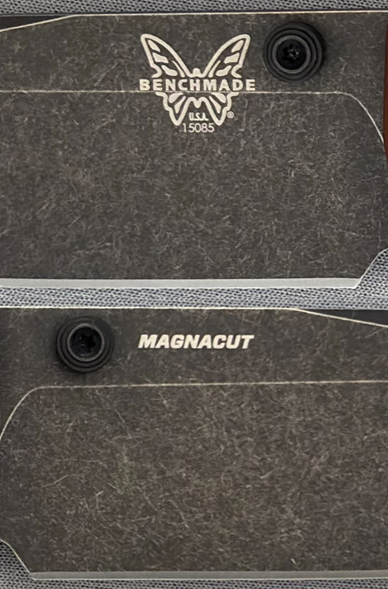
It’s not too bad, but if you hate such visual distractions from an otherwise beautiful blade design, it’s not perfect either. It’s somewhere in the middle between the sterile, virtually no-name Kunwu Excalibur and the abominable billboard on the Microtech SOCOM Elite, which is completely defaced with useless crap text and a bulbous, oversized company logo, all placed in the middle of the primary bevel! Absurd.

So sad.
CPM MagnaCut TECHE
When I can get the ratings data for the knife steels I review (I primarily gather the data from the authoritative KnifeSteelNerds.com as available), I include it here in a section I call TECHE. What does TECHE mean? Well, you could look at the table below and figure it out, but it stands for Toughness, Edge Retention, Corrosion Resistance, HRc Hardness Rating, & Ease of Sharpening. Clever, huh?
Note that all ratings but HRc Hardness Range are based on a scale from 0-10; Hardness is based on the Hardness Rockwell C scale, which technically is between 20 and 68.


** Ease of Sharpening data is not a rating produced on KSN.
HRc Rating
Houston, we have a problem. Benchmade is hardening the illustrious CPM MagnaCut to the same low hardness levels that companies were offering back in 2022, when MagnaCut knives were just coming out and blade makers were still experimenting with how to work with this new, ultra-premium steel. While most medium-to-high-end knife manufacturers are now offering MagnaCut blades in the 63-64 HRc range, Benchmade readily admits the blade on the Mini Crooked River is hardened to a mere 60-62 HRc.
Why? Well, I can only guess. Technically, I’d expect that by now Benchmade should have developed internal expertise on how to properly heat treat MagnaCut steel to its optimal hardness range, which today is typically 63-64 HRc. But when you search for any currently available Benchmade knives made in MagnaCut, they are all just 60-62 HRc, even on knives that cost a mind-boggling $650!
Are they technically incapable of doing a modern heat treat on MagnaCut? That would be shocking news if true. I suspect that the reason is more pedestrian than the lack of technical skill. To do a proper heat treat, there are several steps involved, including the initial austenitizing heating, tempering (which is often done twice), and then a cryo treatment. These steps take time. Time is money, so to save time (and money) to get new knives onto the market, many knife manufacturers will cut corners on time-consuming processes, and an optimized heat treat is a bit of a time suck. Hey, quality takes time!
Perhaps Benchmade is cutting corners on their blade steel quality like they do when using Grivory (aka fiberglass reinforced nylon (FRN) on their handles. Grivory is a cheap product that, while in truth is relatively durable, but the way Benchmade implements it makes it feel flexible and flimsy on even expensive knives. In my review of the Benchmade Shootout, the Grivory handle fit and finish was atrocious for a knife that cost over $335.
To fail to do a proper heat treat on CPM MagnaCut for what is otherwise supposed to be a premium knife is a significant disappointment in the product quality and value proposition of the Mini Crooked River. Geez, even Buck is now making a new Bugout-ish crossbar lock folder (the Range Elite) in MagnaCut, and they already know they need to do CPM MagnaCut at 63-64 HRc. Benchmade, what are you thinking?
The bottom line: Don’t give your money to a knife company who knowingly sells you a knife whose blade is left in an under-hardened, overly soft condition, but is billed as a premium knife. This is not premium. A too-soft blade negates all the advantages of buying a knife with an ultra-premium, super steel blade.

Am I annoyed? Yeah, you could say that.
Blade Dimensions
Where’s the beef? It’s right here, in the numbers.
The blade length is 88.56 mm / 3.487″ with a cutting edge length of 89.74 mm / 3.533″ and a height of 23.99 mm / 0.945″. The spine thickness is 2.86 mm / 0.113″ and has a main bevel edge thickness of 0.56 mm / 0.022″. Related to that, the primary bevel angle is 3.5° with the factory edge bevel angle of 17.5°.
On top of the blade, the swedge height is 2.19 mm / 0.087″ and its length is 57.95 mm / 2.282″. On the bottom side, the sharpening choil has a length of 7.73 mm / 0.305″ and a depth of 3.63 mm / 0.143″.
Lastly, the thumb studs span is 9.40 mm / 0.370″, while the amount of thumb stud in cutting path is 9.16 mm / 0.361″.
Knife Body & Scales
The Benchmade Mini Crooked River’s handle, at least to me, is the more interesting half of the knife. But that said, there are significant issues here as well. So let’s get into it.
Handle
The look of the Mini Crooked River’s handle is my favorite part of this knife. Its why I asked to borrow it, to see and hold it, and write a review. The externally-facing side of the handle consists of 2 parts: 1. a pair of 6061-T6 aluminum bolsters anodized to a burnt copper color; and 2. a pair of black canvas Micarta scales. Both parts are milled smooth. The combination handles feature a slightly contoured surface, which I like and appreciate.

Liners
The bolsters and scales sit atop of a set of full-length, black-coated, steel liners, making the handle feel strong and sturdy, engendering confidence in the quality of the knife, a confidence that is sorely missed in so many of the Benchmade knives made with Grivory handles. The liners have circular cutouts that help reduce the handle weight.
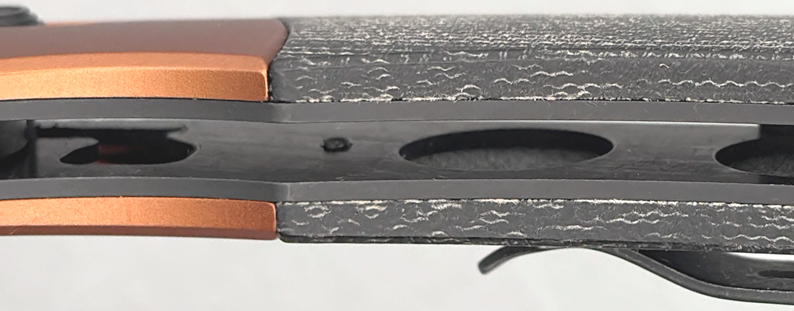
Note that the liners are stacked, not nested. This is a much less-expensive, much-less-premium knife handle configuration. I’m disappointed.
The knife comes with the blade centered, which is good news.

Pivot
The pivot faces on the Benchmade Mini Crooked River are rather plain. The show side is a black-coated, shallow steel dome. The clip side looks like a basic, button-head machine screw using a T10 socket (just look at the stop pin screw just above it – pretty similar, right?). Both pivot faces feature black-coated pivot collars. Yawn.

When you have a Benchmade knife, you can safely assume the pivot runs on phosphor bronze washers. Certainly this is true for the Mini Crooked River.
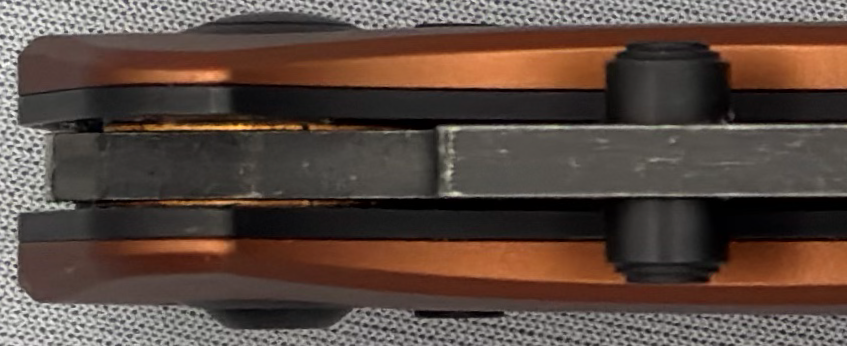
The washers typically take some time to wear in before they achieve perfect smoothness, but it’s not supposed to take long. The pivot on the Mini Crooked River I am reviewing came to me in disappointingly poor condition. The knife was openable with the thumb studs, but would not close under the weight of the blade when the lock was released. When the blade was slowly moved by hand, I felt a surprising amount of grainy and gritty resistance. I typically needed to push the blade down with my index finger to close it. And I must note that this Mini Crooked River knife is borrowed, so I am not the first person to handle it.
SIDEBAR: What are Self-Lubricating Phosphor Bronze Washers?
Have you heard anyone mention this in a review? There are folks out there who confidently explain to you that phosphor bronze washers are what they call “self-lubricating.” Huh? They lubricate themselves? How does that work, boss? Do PB washers contain a secret reservoir of oil? Are they like olives in that when squeezed, oil oozes out? Could it be that phosphor bronze washers are actually a form of Damascus metal alloy made of copper, tin, phosphorous, and 50 grade motor oil?
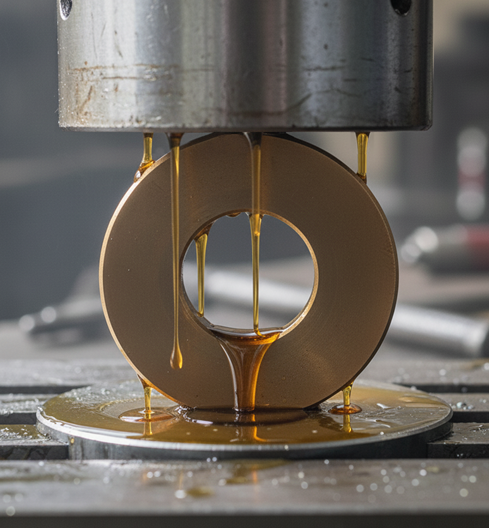
Umm… No.
Note: There are washers made of oil-impregnated sintered bronze (Oilite-type) or bronze with embedded solid lubricants (graphite / PTFE), but phosphor bronze washers used in folding knives are not made from these materials.
The claim that washers made from phosphor bronze metal alloy are “self-lubricating” is absurd on its face. To make such a claim is either a laughably bad joke at best, or more likely, a profound misunderstanding of simple materials science. So how could anyone come to such a sadly mistaken belief? (Perhaps they also believe the earth is flat, the moon landing never happened, and the Monkees were just a band of posers who didn’t make their own music?) It’s more likely that they heard it from other misinformed fool, and not bothering to check it out, they just parrot it to others like in a bad version of a Misinformation Telephone game.
To get to the bottom of this tall tale, this non-debate, this false assertion, this foolish nonsense, let’s take a quick dive into pivot mechanisms, materials used, and how they work.
Both bearings (rolling friction) and washers (sliding friction) provide a friction reduction interface between 2 surfaces (in the case of pocketknives, the blade tang and the handle liners).
Bearings, the presumed “non-self-lubricating” type of knife pivot, friction reduction mechanism, includes thrust bearings (axial rollers) and ball bearings (radial spheres). Bearings used in folding knife pivots are made from either stainless steel (commonly 440C) or the much preferred, hard ceramic (typically Si₃N₄ aka silicon nitride). While some knife pivots use loose bearings (aargh, OMG, NOOOO!!!), most are housed in caged frames made from either stainless steel, brass, phosphor bronze, or nylon polymer.
The pivot action of bearings provides a very low rolling friction. These bearings are so smooth and durable that they can be run dry (aka no lubrication!) and still provide smooth action. That said, knife manufacturers typically advise lubricating the pivot bearings in their knives. Not because the ceramic balls need it, but instead, lubrication benefits the bearing housing, as it dampens squeaky sounds and grinding vibrations, as well as smoothing the tracks in which they rest.
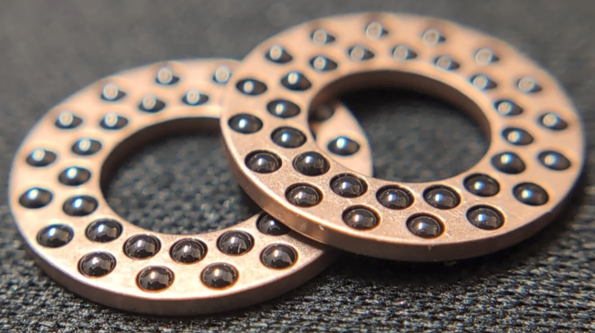
The key downside to bearings is that they leave open spaces between the blade tang and handle liners due to the ball-spacing cavities between individual bearings. When dirt and debris collect in these spaces, the pivot action can become gritty and rough. You’ll note that many bearing cages have a taller outer rim to help cover those ball-spacing cavities and minimize gunking up the bearings, but it will still inevitably happen if you actually carry and use the knife.
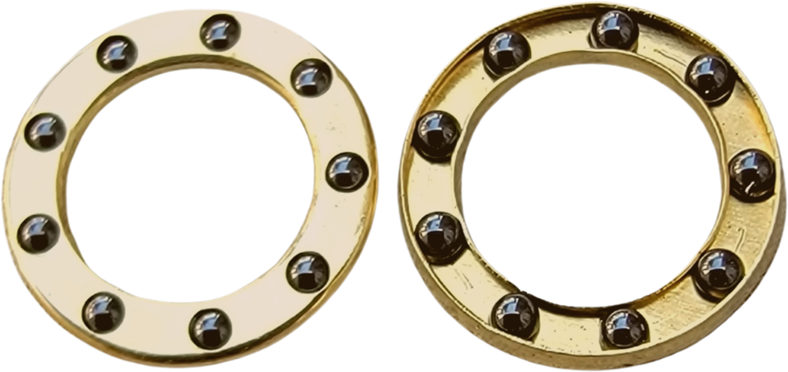
Next, we have PB pivot washers (you know, those self-lubricating, sliding friction thingies). Pivot washers come in a variety of materials, including stainless steel, nylon / polymer, PTFE (Teflon), but most importantly, phosphor bronze. PB washers are typically the version used on high end knives that use washers. The material, a metal alloy made of copper, tin, and phosphorous, is known for its excellence at retaining a thin film of applied lubricant (lubricant it doesn’t provide itself, by the way!) due to its porous microstructures. This gives the pivot what some users describe as a smooth, hydraulic feel (of course, only after the washers become polished smooth by the friction of the steel blade tang against the handle liners).
One big benefit of PB washers is their naturally lower coefficient of friction when sliding against hardened steel. Did you catch that? Is my email reaching your Inbox? I’m not sure, so let’s break this down.
It begins with the fact that the phosphor bronze alloy is softer than steel, so PB washers take the wear at the pivot joint rather than having a steel-on-steel contact. The “coefficient of friction” (CoF) is just a means to measure the amount of friction between 2 surfaces. A low CoF indicates the 2 surfaces slide against each other more easily, less force is required to start and continue the sliding motion, and less heat is generated in the process. Another benefit of PB is that it’s highly compatible with most knife pivot oil & grease lubricants. The last big benefits of PB washers is that they reduce the larger gap bearings place between the blade tang and liners as well as eliminate the bearing ball-spacing cavities, both of which protect the pivot interface from dirt and grime (there can be a lot of grime, my friend, so much grime!).
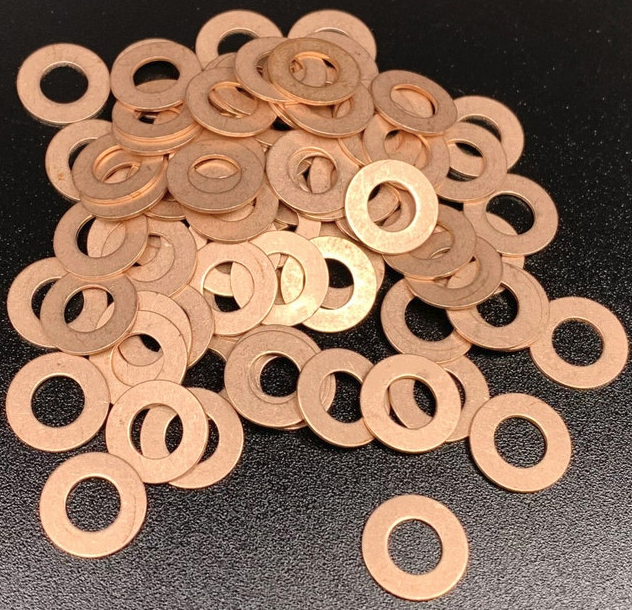
But the takeaway here is that phosphor bronze washers, unlike bearings, do require externally-sourced lubrication. They retain what they receive rather well, but they must be properly lubricated to function. They do not inherently have it in them for use.
The downside of PB washers is that they don’t have that “slicker than snot on a doorknob” action as do bearings. But it’s also interesting that the best bearings-equipped knives do not have that guillotine action of cheap bearings-based knives. The makers of those knives tune their pivots to have the beautiful, buttery smooth action of a well-worn in set of washers along with the icy glide that comes with bearings.
It is accurate to say that phosphor bronze washers are lubricious but take note – PLEASE: phosphor bronze washers are NOT self-lubricating. Sheesh!
Now back to our regularly scheduled program.
Beta-Level Product Releases
To be fair, I have put the knife’s pivot through its paces, and I definitely feel an improvement since when I first handled it. However, I personally have a problem with this situation.
Some knife manufacturers sell knives that are intentionally not “pre-broken in” (meaning the pivot components and blade tang interfaces were not polished, not really even prepared, just assembled). They tell buyers that we should expect this and that we must do the break-in work to eventually make their knives work to a level of satisfaction we accept. But how many people have you heard complain about some knives that either take forever, or sometimes just refuse, to break in? This complaint seems to be even more common with Spyderco knives, but certainly many other manufacturers get this criticism as well.
I really don’t like having to buy products, especially expensive ones, that are not ready to use. Yes, to do the proper preparation of polishing and lubricating washers, liners and blade tang surfaces would raise the cost of a knife. I understand that budget knives have slimmer margins, so this is a cost-saving measure for them. But when you are asked to pay several hundreds of dollars for a knife that, out-of-the-box, feels like garbage, is just that – it’s garbage.
Am I annoyed again? Yeah, I suppose so.
Locking Mechanism
The Mini Crooked River comes equipped with the famed Benchmade AXIS Lock. So how well does it work? Well, if you pull back on both studs of the crossbar pin to release the blade, it works fine. But when you pull back on 1 side alone, it will not close. Why? Great question!
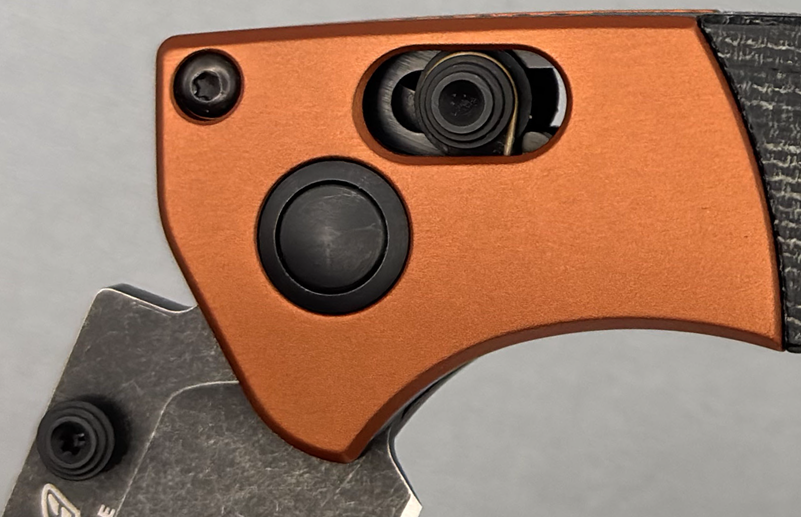
The lock appears to allow far too much lateral play in the movement of the crossbar pin.
I have an old Benchmade North Fork 15031 knife I purchased back in 2016. It never got a lot of use (it got socked away in a drawer and sat unused for years until it was just recently rediscovered), so the knife is barely “broken in”. The AXIS Lock with the original springs on the 9-year-old North Fork feels different.

It feels much more robust and smooth. And yes, you can release the blade with just one digit pulling a stud on either side of the crossbar pin. It feels solid and strong. When I look at the handle spine of the North Fork, I see the crossbar pin remains perpendicular to the spine no matter which side is used to retract the lock. Apparently in the past 9 years or so, the engineering quality at Benchmade has suffered a fair bit of setback. That is a genuine disappointment.
The AXIS Lock on the Mini Crooked River exhibits only a minor bit of lock stick (assuming you retract the crossbar pin using both sides of the bar studs). The blade play is almost non-existent (only hints of wiggle).
Detent
As for the detent, well, it’s a crossbar lock, where having enough detent to keep the blade from flopping out of the closed position is the expectation, but little more. The detent on the Mini Crooked River is better than one might expect, as long as you’re keeping in mind that this is an AXIS Lock, not a frame lock. Relative to other crossbar locks, though, it’s fine.
Stop Pins
Benchmade installed the open stop pin in its typical location at the top front of the knife handle (in this case, in the bolster). But atypical for most other knife makers, Benchmade continues their odd tradition of intentionally marring the design appearance of their knives by needlessly insisting upon using external screws to attach the open stop pin. It’s like they’ve never heard of the idea of using either liner-based, flush-mount machine screws, or better yet, floating pins with stepped ends, both of which work underneath the scales.
Wowzers! That’s a revolutionary idea, I know, but for Benchmade, I guess that would detract from their registered design trademark of defacing the design aesthetic of a beautiful handle by punctuating it with needless, external fasteners. Hey, at least in the case of the Mini Crooked River, the screw is black.
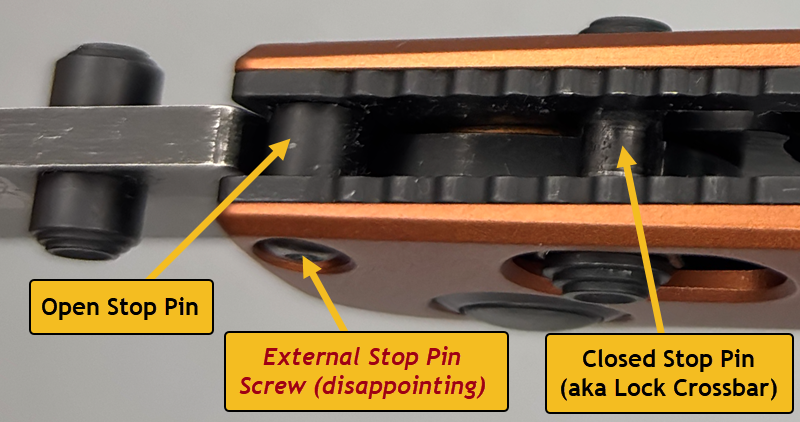
That’s better than how Benchmade managed the handle design of the Mini Adamas with lovely dark, marbled carbon fiber scales, defaced with external screws made of polished steel.
The crossbar pin of the AXIS Lock serves as the close stop pin. I am happy to report that the close stop pin does not hit the sharpening choil near the edge bevel. That’s good news!
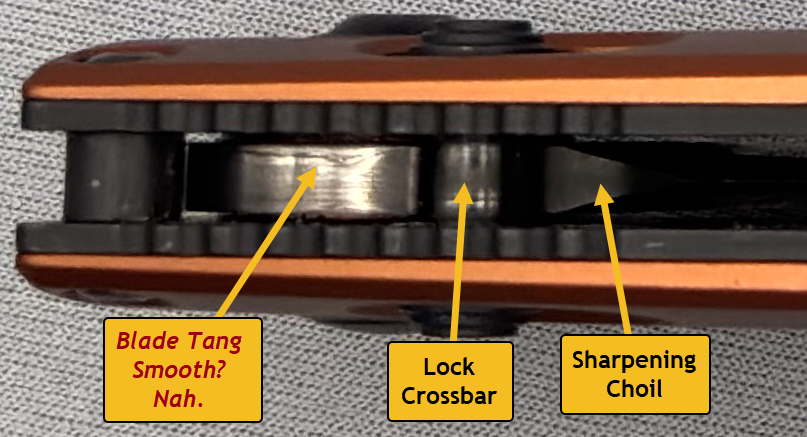
Backspacer
The Mini Crooked River does come with a backspacer. It’s made with another piece of the same black canvas Micarta used with the scales.

The only distinct feature of the backspacer, aside from the emerging threads of the canvas from the Micarta which makes the piece always look dirty and debris-ridden, is the decorative crenulated texture, sort of like the top of the keep of a castle.

Of course, crenulations are not to be confused with dentils.

I hope that helps.
Lanyard Mount
There is much joy in Lanyardland today. When the last 3 dudes in the world who still care about lanyards, Jordan, Kent, and Owen, heard that Benchmade did them a solid with the Mini Crooked River, they rejoiced, singing the praises of Benchmade and sharing with one another such exciting stories of what they’d do first with their new knives (after tying on their special lanyards in specialized knots with their own signature bead, of course).
But then I broke the shocking news of what Benchmade charges for this knife. After a moment of standing there, slack-jawed and speechless, they went back to their regular grumbling and grousing about the sad state of their lives, living in their respective mothers’ basements.
Too bad, so sad.
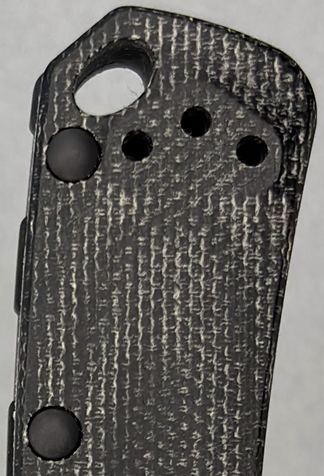
Handle Dimensions
Do you believe in numerology? Who cares. Let’s document the handle specs.
The handle length is 114.68 mm / 4.516″, giving the Mini Crooked River a blade-to-handle ratio of 0.77. The closed knife handle height is 28.58 mm / 1.125″ and the handle thickness is 12.36 mm / 0.487″. The distance from the pivot center to open knife’s balance point fulcrum (where 0.0 is balanced at pivot) is 17.05 mm / 0.672″ back.
The distance from the pivot center to the thumb stud (a higher number may mean less leverage for easy, fast opening) is 24.52 mm / 0.966” (a fairly high number, this, at least per my data). However, given the thumb stud angle from the knife’s vertical center when closed is 31° (a rather shallow angle per my data), combining the longer thumb stud distance with the shallow stud angle means the knife is still easy to open. This is further enhanced by the fact that Benchmade offered generous clearance of 3.09 mm / 0.122″ from the thumb stud bottom edge to the edge of the scale, ensuring you don’t need to dig to get at the thumb stud. By the way, the width distance between the crossbar lock pin thumb studs is 12.00 mm / 0.473″.
Lastly, the length of that stringy backspacer is 48.31 mm / 1.902″.
Ergonomics
The Mini Crooked River is a mixed bag of ergo design and comfort. I generally like the handle feel with the slightly contoured scales, the chamfered scale and bolster edges and the nice finger choil.
The interior edges of the liners along the perimeter of the handle possess a very sharp 90° angle; luckily, you’ll only feel that sharp edge by running your finger across them, not in your grip.

The big ergo fail of the handle is the upward sloping, extended length bill of the stamped steel pocket clip. That bill may as well be a hot spike, given the way it digs into your palm when you hold the Mini Crooked River in a common saber grip as shown below.
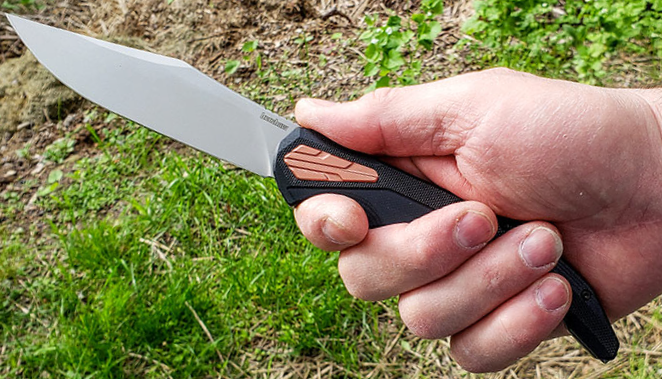
It’s terrible. Did anyone at Benchmade even pick up this knife before it got the green light to be shipped?
The other chief ergonomic concerns are the studs. You know The Knife Karen likes me some studs, but I like them with soft touches, not sharp and abrasive little buggers. I’ve already mentioned earlier the fact that the blade thumb studs are hollow point nasties, sporting recessed T6 sockets in case you want to replace them – which is a great idea, given the perimeter of the factory studs’ top step are really sharp, skin-abrading scrapers. Who thought this was a good idea? Did anyone test these? If so, did they simply say, “These are good enough”?
However, the stud nastiness doesn’t end there. The AXIS Lock bar pin studs are similarly sharp and abrasive to the skin. But here’s the biggest kick in the pants of it all – there’s no Torx socket at the bottom of these sharpened hollow points. They’re just designed to be barbarous, finger-abrading, accoutrements for the visual design! But I suppose knocking down those sharp edges was too costly to do, so Benchmade left them on the knife rather than providing something more ergonomically pleasing to their customers.
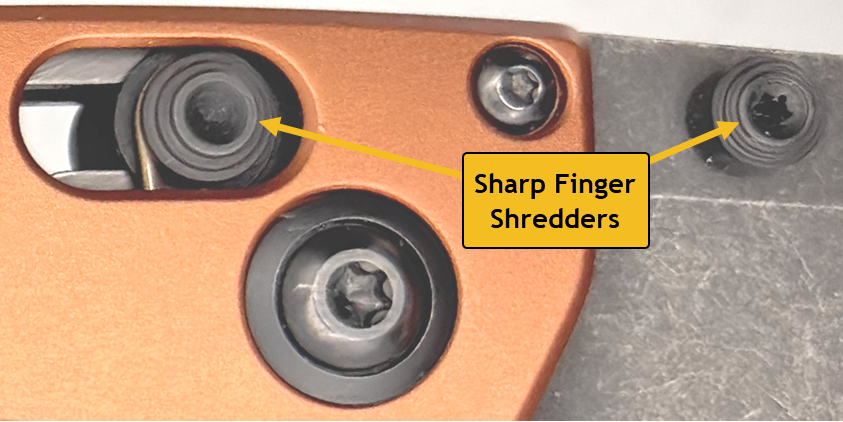
I can hear the arguments now. These are left intentionally sharp so hunters can use the knife with gloves. Sure. So then why not just use 40-grit sanding media or sharp, double-cut, carbide burr tips?
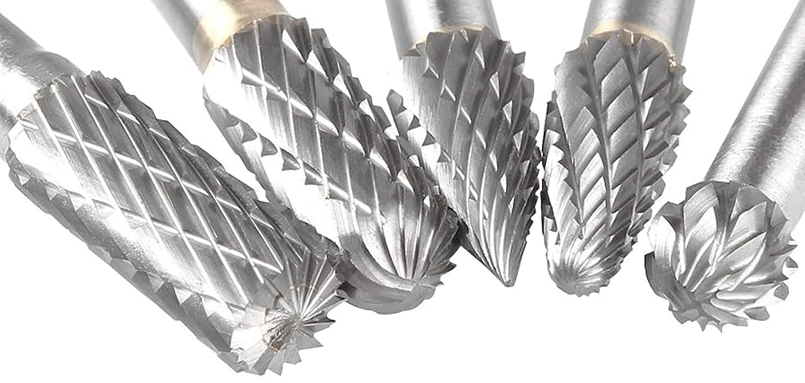
That’ll really help hunters operate the knife when wearing thick gloves when their hands are immersed in slippery animal guts and goo.
I don’t know – perhaps it’s just my tender Knife Karen fingertips, but I didn’t find the studs to be comfortable to use. I guess I need to go hunting to appreciate this “feature”.
Hardware
I already mentioned the ergonomically disastrous, stamped steel pocket clip with its needlessly high front tip bill. Maybe this tall bill is designed to get the clip over the thick edge of a pocket on a winter hunting parka. Fine. But it really sucks when you hold the knife in your bare hand. Just sayin’.
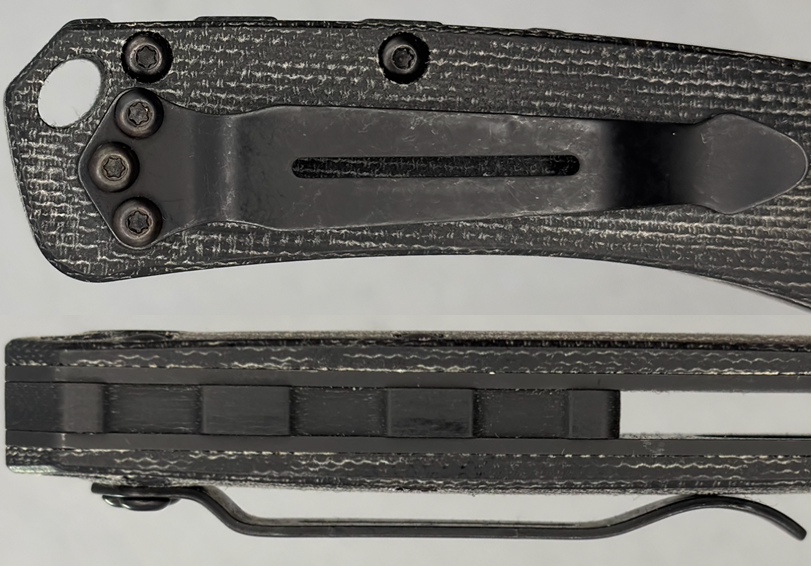
The clip length runs 58.69 mm / 2.311″, which gives the knife a clip-length-to-handle percentage of 51.18%, even though many people prefer it be no longer than 50%.
I seem to be all piss and vinegar here, aren’t I? Well, I can give Benchmade a little love when it deserves it! Case in point: they use domed cap Chicago screws on the show side of the handle, giving the handle a much cleaner look. Nice!
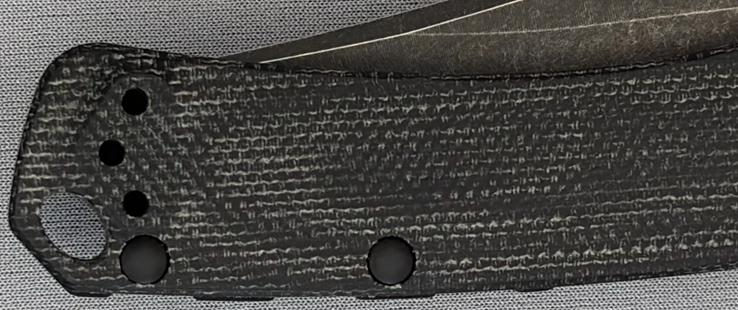
Weight
The Benchmade Mini Crooked River weighs in at a very reasonable 94.67 g / 3.34 oz. Given the blade length of 88.56 mm / 3.487″, the knife has a svelte weight-to-blade-length ratio of 1.07.
Design Considerations
Let’s talk about fit and finish (or lack thereof). There are a lot of small issues here. A LOT of them. None are truly dealbreakers by themselves, but in aggregate, they add up to a serious quality control problem for what is being sold as a premium pocketknife. Let’s have a look.
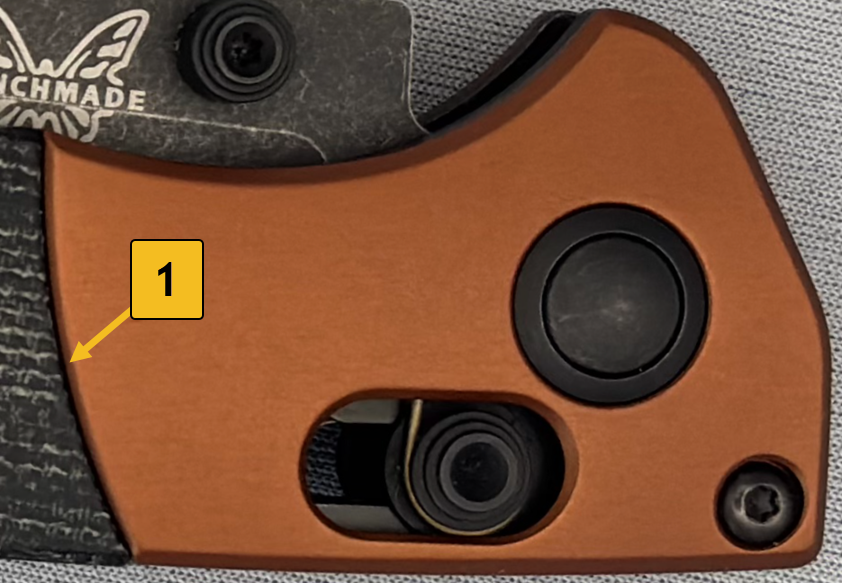
First off, at callout #1, the seam between the bolster and the scale show a noticeably large and unappealing gap between them. At the very close-up view above, you might be inclined to think this was an intentional design feature. Sure. And the latest iPhones come equipped with pre-cracked screens, right?
The fact of the matter is that the Mini Crooked River is categorized as a hunting knife, a tool used to dispatch, gut, skin, and break-down your quarry. Why on earth would you leave a large gap between handle materials that will be a perfect place for guts and goo to collect and later stink to high heaven?
No, this isn’t a design feature. This is lazy manufacturing and shoddy quality control.
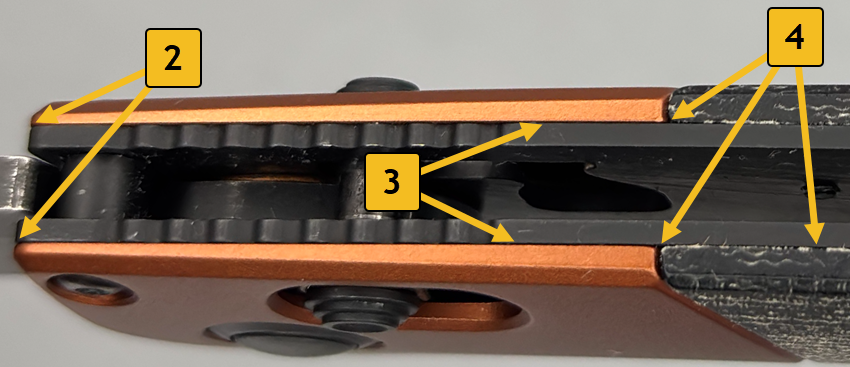
Callout 2 shows fitment issues at the seams of the aluminum bolsters and the steel liners underneath. To be frank, they aren’t the same size. Yes, they’re close, but if you run your fingers over the seam, you feel (and see!) the notable uneven ledge. Callout 3 shows the entire length of the seams between the bolsters and liners are simply poorly mated.
But callout 4, a different perspective of callout 1 above, shows how badly the seams are mated there, as well as the seam between the scales and the liners. This is clearly not a design feature. This is just shoddy craftsmanship.

Callout 5 clearly shows the continuing failure to match the seams between the bolsters and the steel liners from the other side of the handle, and this example is particularly poor. Callout 6 shows another issue that I mentioned much earlier in the review, when I speak of the roughness of the pivot. Let’s be clear. It may also be that the blade tang was simply not properly finished. What a disappointment.
Callout 7 again identifies the ongoing seam gaps between the bolsters and the liners. And callout 8 is the other side of the terrible intersection of the bolsters, scales and liners.

Callout 9 shows that the problems of fitment are not reserved only for the front. Getting usable photos of the gaps between the black liners and the black Micarta scales wasn’t easy, but it doesn’t mean there weren’t any problems. The butt of the handle was a particularly egregious mismatched seam of handle materials.
And lest you think me much too picky and an arbitrary complainer about small details, I invite you to go back to my previous post and take a look at how the Vosteed Porcupine compares in terms of fit and finish. The comparisons are shocking.

Vosteed produces a beautiful knife with outstanding fit and finish. It comes with a shorter blade made from Alleima 14C28N rather than Benchmade’s longer CPM MagnaCut blade, but both are working with Micarta on top of stacked steel liners. The Vosteed has a basic pocketknife handle. The Mini Crooked River has a nicer handle featuring anodized aluminum bolsters, but I’m focusing here on the fitment of materials, not the materials themselves. The fact is that Vosteed simply blows away Benchmade in terms of the fine craftsmanship details that truly add value to a knife.
And by the way, the Vosteed Porcupine only costs $69. Benchmade, there is no excuse for this shoddy fit and finish work. Where is the value? You must either pick up your game or be left behind.
Original Packaging
Benchmade is known for their use of heavy, rigid, paperboard, full telescope boxes and a dense, black, medium-soft, large closed-cell foam lining pressed into the lower tray.
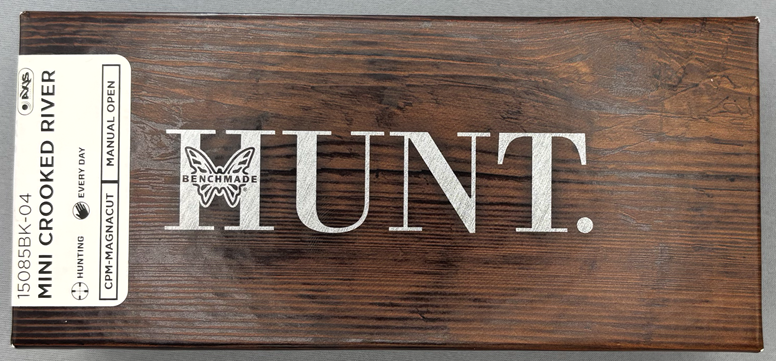
Interestingly, despite the definitions of the Benchmade knife classes presented earlier in this post, in which we see that Benchmade has identified the Mini Crooked River as a Hunting Class knife, the box clearly states that this knife is Blue Class. But on the Benchmade website’s Product Classes > Hunt Class page, all the Crooked River series of knives are Hunt Class. Even they don’t what these product classes actually mean. Sheesh.

Did you notice that the box clearly states that the Mini Crooked River knife features SelectEdge (recall that this is Benchmade’s “proprietary” 14° edge bevel!)? Well, if you go to the SelectEdge webpage on the Benchmade website, the Crooked River line of knives is not included among the knives that have that feature. And if you go to the Benchmade Mini Crooked River product webpage, SelectEdge is not listed as a feature of this knife.
Geez, Benchmade! Get your product marketing team together with the website team and find out if any of them know how to do their job! It’s not apparent that they do.
Inside the box, the knife is enclosed in the traditional black satin, drawstring bag. Included in the box is a thick cardstock AXIS Lock slip and a rectangular-folded Use & Care sheet, and is lined with their special large, closed-cell, press-shaped foam that is somewhat soft to the touch (the foam lining is one of the important features that separates legit Benchmade knives from counterfeits).
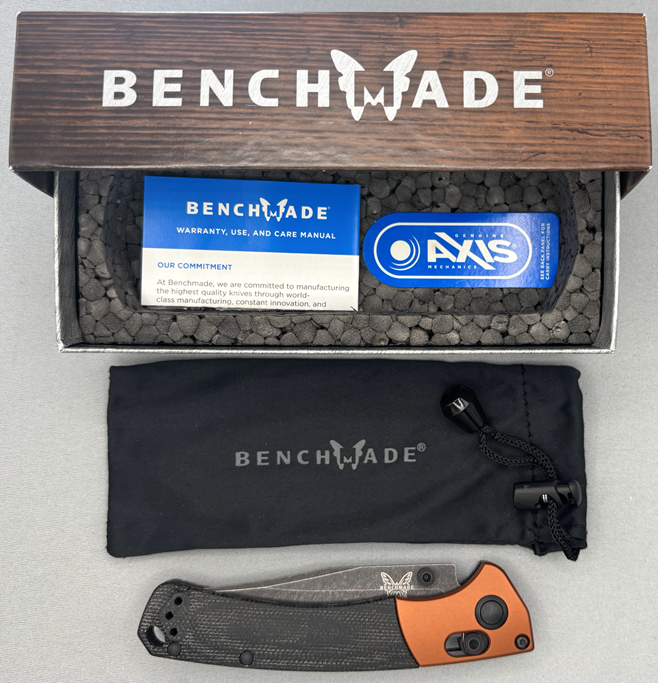
Knife Karen Nitpicks
I am a reasonable woman. Most women are. Most of the time, anyway! But then something happens. Something that’s unjust, that disappoints us, that annoys us. And frankly, we’re tired. In one form or another, we’ve seen this crap all our lives. But we are no longer afraid to stand up, to call out the BS. So out of politeness, without intending to make a scene (even though it ends up that way anyway), we ask for the manager so we can seek justice for the wrong we’ve witnessed.
Yes, I am The Knife Karen. I don’t cause a scene. I don’t make a fuss. But when I see an annoying injustice, I speak my mind (or at least write about it). And when I’ve reviewed disappointing knives, I say so. Sometimes knives have 1 or more poorly executed features. Sometimes the knives offer zero value because for what you get, the price is too damn high. And then sometimes it’s both.
I really need to speak to the manager of Benchmade, please.
- The blade is annoying because:
- The blade edge grinds are uneven! Please stop assigning your junior interns to grinding the edges!
- The blade hardness is at least 2 HRc points low for MagnaCut! What year is this – 2022?
- The blade originally received a clean, robust DLC finish, but then Benchmade decided to run those coated blades through a stonewash tumbler, which removes so much of that high-end coating that it ends up looking like cheap blackwash. Who’s absurd idea was that?
- For a knife that is supposed to be used in slippery, slimy, blood & guts tasks, it’s astonishing that the blade has no jimping! Ridiculous!
- The thumb studs come to sharp-edged hollow points at the apex, which makes them needlessly abrasive to thumb skin. No blade spine jimping, but you apply an abrasive tip onto the thumb stud. SMH.
- The handle is annoying because:
- The open stop pin uses dual, external mounting screws! Hey BM knife designers, use Google and look up “floating stop pin”! They’re available now!
- The handle uses stacked liners instead of nested. This is a cheap-out play, a feature found on basic, budget knives. The Mini Crooked River is NOT a budget knife.
- The AXIS Lock won’t release with one finger – the lock bar has too much lateral play and binds up. Where’s the quality control?
- The ramped bill of stamped pocket clip is a terrible choice – it digs into the palm of hand when you use a common saber grip to hold the handle. Garbage.
- Out-of-the-box, the pivot is not just un-broken-in. It has a genuinely grabby and gritty pivot that is not fit to ship. Appalling.
- Can you believe it? BM is still shipping knives with T6 handle fasteners! Absurd.
- The handle fit and finish is annoying because:
- The knife has a huge, deep gap between bolster and handle scales. This can’t be a design feature – this is a hunting knife! Benchmade quality of craftmanship has collapsed.
- All along the handle perimeter, at the seams where different materials meet, such as the liners on the bolster and the liners on the scales, are not done well. The knife’s fit and finish detail work is less than mediocre. Budget knives are regularly done better than this! Benchmade quality of craftmanship has collapsed!!
- For all the above, considering the value, the price is too damn high! (See below.)
Price
Let’s be honest here. The knife has a comfortable-ish handle (well, only if you get rid of that palm-stabbing pocket clip). The blade is thin and is easy to deploy (despite the crappy, abrasive thumb studs). The handle looks handsome with those burnt copper bolsters.
But all that said, reread the Knife Karen Nitpicks section above. There’s a lot of nits to pick over. And for a knife that has all those issues and more, Benchmade will charge you a full $320!
And in this case, even authorized Benchmade dealers must change the full, freakin’ MSRP. No dealer discounts allowed. And in my opinion, regardless of the fact that it’s a US-made knife, which automatically makes the costs higher, the basic value of the Mini Crooked River is simply not there.
This is not a $320 knife. Do you think Hogue or US-made Kershaw, for the same knife, would cost this much? No chance. How about Spyderco? Hmmm… well, maybe. Have you priced a Shaman lately? SMH.
Verdict
The Benchmade Mini Crooked River is a folding knife designed for hunters. It comes with an 88.56 mm / 3.487″ long, DLC-coated, clip-point CPM MagnaCut blade and sports a black Micarta handle with burnt copper-anodized aluminum bolsters. It’s a good-looking knife, one that if was given to me, I might carry it as an EDC. However, the knife I’m reviewing is borrowed, and it will be sent back to the owner immediately after I publish this post. And I will not be buying this knife.
Why? Well, if you skipped the entire post just to read the conclusion, that’s cool (although you’ll miss a lot of fun and good info!). The knife has a multitude of little problems, likely none of which are show-stoppers in their own right. But when you sum them up, there’s a clear trend on sub-standard fit-and-finish issues all across the handle, inadequate heat treatment for the hardness potential of MagnaCut steel, unevenly ground blade edge bevels, and many questionable design decisions, all discussed above in detail. (See? I told you it would be worth reading the whole post!)
I’m not gonna lie (this time), I’m not sure that this is really a hunting knife, though. To me, it’s really just an EDC knife (the box identifies it as a Blue Class knife, which are BM’s EDC knives!). Or perhaps it’s a city dweller’s idea of what a hunting knife would be. Meh.
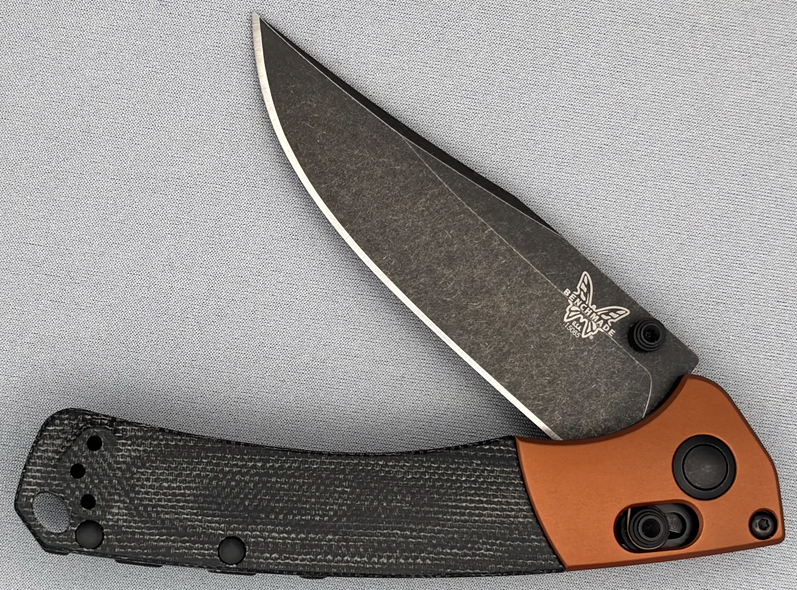
It’s not a bad knife – not at all! But when you consider the whole of the parts of this knife, the good, the disappointing and the frustrating, the overall value proposition is called into question. But when you learn that Benchmade is charging $320 for this knife, that’s a terribly bitter pill to swallow.
In fact, go to your favorite online knife retailer (one with a very large inventory) and use the filters to look at folding knives that have a maximum cost of $320, then sort the list from high price to low. Take a look at that list of knives and see the features they offer (ignoring other Benchmade knives, of course!). Look at the handle materials (titanium and carbon fiber, babycakes!), the blade steels (and how well they are hardened!), the blade finishes (hand-rubbed satin is so sweet!), blade features (crowned spines for the win!), the multitude of visual designs, the various locking mechanisms, high-end, decorative accents (did someone say Timascus?), assisted and automatic knives – the list goes on and on.
Yes, I realize that Benchmade are US-made knives, and we are told that US-made knives always cost a lot more. But Hogue, Pro-Tech, Zero Tolerance, Kershaw, Microtech, Heretic, Spartan, Spyderco, Case, Buck, CRKT, Cold Steel, SOG, White River, Tactile, even Leatherman, plus many more, sell US-made knives. And yes, I also know that some of those brands sell both US-made and knives made offshore. So in that online knife retailer’s webpage, select the Country of Origin filter for USA.
Somehow, at some point in the past, Benchmade decided that their brand and the knives they make have a higher value than other US-made knives. Maybe long ago they could have made an argument for that (maybe), but not today, not anymore. The proud craftsmanship of the past is no longer there. The old, excellent quality control is now completely absent. The heat treatments are inadequate (all their MagnaCut blades are only hardened to 60-62 HRc, whereas the common standard these days for MagnaCut is at least 2 points higher). Every way to cut corners have been cut.
The one corner that has not been cut is the Benchmade price. As a result, the value proposition for Benchmade knives has evaporated. While I have not handled every Benchmade knife, those new releases I have handled are consistently unimpressive knives and the prices are consistently far too high for the value presented.
The Benchmade Mini Crooked River knife is a lot of things to a lot of people. It may even be the perfect knife for you. But rest assured, no matter who you are, it is not a $320 knife. Perhaps, at best, it’s a $150, maybe a $180, knife, but that’s it. The Butterfly tax will live on in infamy. Enjoy! ![]()

